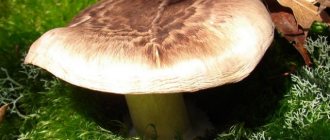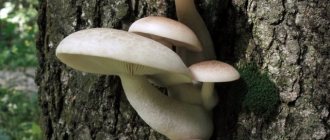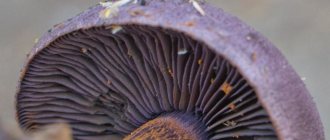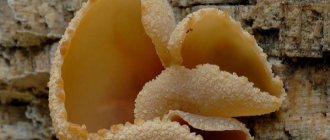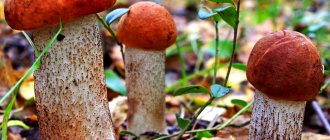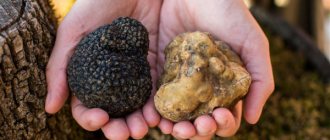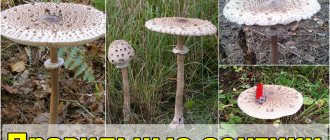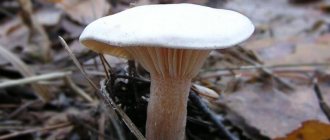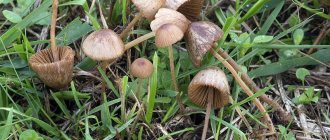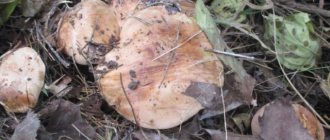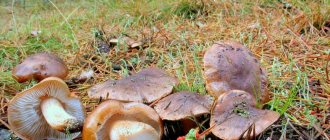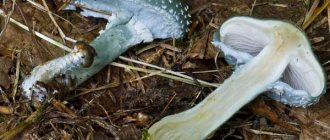The family of Rowadaceae (or Tricholomaceae) includes up to 2,500 species of mushrooms, among which the greenfinch or Tricholoma equestre mushroom is very well known. It is characterized by a specific greenish color, for which it received its Russian name.
This species is popularly called differently, for example, green, golden or lemon row, jaundice, brilliant green, green mushroom, etc. The mushroom is eaten, but only with proper mechanical, physical and thermal treatment, otherwise it can cause intoxication of the body .
Description of the mushroom
The fleshy cap is green-yellow in color with a yellowish-brown center and has wavy edges. Its surface is very sticky, so it is constantly covered in grains of sand and debris. It is because of this that many mushroom pickers are in no hurry to collect them. Washing all the sand so that it doesn’t squeak on your teeth is not an easy task.
The diameter of the cap is 3–15 cm. At first it is convex and then becomes flat. The pulp is dense white, yellowish under the skin of the cap, mealy and pleasant to the taste with the aroma of fresh flour or cucumbers, if the mushroom grows near a pine tree. The plates are located frequently, they are quite wide with notches, and are colored greenish-yellow. Spore powder is white. The leg is strong, low - 4–6 cm in length, 1–2 cm thick. Colored in the same way as the cap. Completely hidden in the sand.
Nutritional value of greenfinch
The mushroom is edible and is included in the 4th nutritional category.
Chemical composition of greenfinch (100 g of product contains):
- proteins - 3.09 g;
- carbohydrates - 3.26 g;
- fat - 0.34 g;
- water - 92.45 g;
- ash - 0.85 g.
It is rich in B vitamins, contains vitamin C, D, E, K and PP, a number of amino acids and minerals - calcium, selenium, magnesium, potassium, iron, manganese, phosphorus, copper, zinc and sodium, fiber.
Nutritional value of 100 g of fresh mushrooms is 28 kcal.
Dishes made from this type of mushroom are contraindicated for people with poor blood clotting, as it contains toxic substances that give it a green color. And also, people with an allergic reaction to them, kidney disease, pregnancy and lactation, hypervitaminosis, and children under 12 years old should not eat mushrooms.
The nutritional value
Greenfinch is not very high in calories, having only 19 kilocalories for every hundred grams. It consists of 46% protein, rich in valuable amino acids.
The other part of its composition, 49%, is occupied by carbohydrates, represented mainly by glycogen. And the fats present in the composition (5%) are mainly expressed in the form of phosphatides, lecithin and cholesterol.
Green grass protein has a whole range of amino acids beneficial to humans:
- tryptophan;
- arginine;
- lysine;
- serine;
- valina;
- glycine;
- histidine;
- threonine;
- isoleucine;
- aspartic acid;
- leucine;
- glutamic acid;
- methionine;
- phenylalanine.
- cystine;
- proline;
- tyrosine;
- alanine
Greenfinch is very rich in micro- and macroelements, among which the most is phosphorus, and also includes:
- iron;
- potassium;
- calcium;
- magnesium;
- zinc;
- selenium;
- sodium;
- manganese;
- copper.
Vitamins are also well represented in this mushroom in the form of:
- vitamin C;
- vitamin B6;
- vitamin B12;
- vitamin E;
- riboflavin;
- thiamine;
- vitamin D;
- vitamin D2;
- nicotinic acid;
- vitamin K1;
- pantothenic acid;
- folic acid;
- choline
Where and when do they grow?
Greenfinches can be found in the northern forest zone. She prefers to settle in dry pine forests, on sandy and sandy loam soils. They can rarely be found in deciduous forests. They go “hunting” for them at the end of summer, when the amount of precipitation increases. The sand becomes wet and the mycelium “wakes up.”
The first greenfinches are found in early August, the last - in mid-September. But, if the Indian summer drags on, individual mushrooms can be found in November. They grow singly or in small groups of 5-8 pieces. The mushroom is almost never wormy.
How to distinguish edible greenflies?
It is possible to distinguish an edible greenfinch from its poisonous or simply inedible counterparts. You just need to know the subtleties of appearance and distinctive features of each mushroom:
- The row is sulfur-yellow. Can be distinguished from greenfinch by the color of the fruiting body. Hers is colored yellow. Its pulp does not have a pleasant aroma; it has a strong unpleasant tar smell and a bitter taste. But they appear with greenfinches at the same time, and prefer to settle in the same places.
- The row is sultry or spruce. The mushroom is smaller in size, has a burning taste and an unpleasant odor. Often grows in the same forests as greenfinch. It is worth taking a close look at the hat. Although they are similar in color - in the spruce row it is light yellow with olive inclusions, the shape is significantly different. In an inedible representative, it resembles a bell with a depression in the middle.
- Death cap . The pale toadstool has a ring on the stalk and a volva - a blanket that protects the young body of the fungus. The plates and legs are painted white, and the edges of the cap are smooth.
- Cobweb. Inexperienced mushroom pickers may confuse the greenfinch with the spider web. They are indeed similar in appearance, but cobwebs grow in completely different places - they are not found in pine forests or spruce forests. The spider web also accumulates a lot of mucus on the underside of its cap.
The mushroom is similar to the conditionally edible green russula. You won't be able to get poisoned, but their cooking technology is different.
The benefits and harms of mushrooms
The beneficial properties of greenfinch are easily explained by its impressive composition of nutrients. But when consuming mushrooms, moderation must be observed. Mushrooms contain substances that suppress pathogenic microflora, in particular staphylococci, thin the blood and cleanse it, and normalize the functioning of the cardiovascular system. Greenfinches have an effect on bone tissue, strengthening it, and the digestive system, improving intestinal motility.
Despite the fact that the mushroom is edible, several cases of fatal poisoning have been recorded. The reason was overeating greenfinches. Do not forget that they contain a toxin that destroys muscle tissue. Long-term consumption of mushrooms has a negative impact on health:
- muscle weakness is observed, which is expressed in rapid involuntary contraction of the limbs;
- disorders of the cardiovascular system occur;
- liver cells are destroyed;
- there is a malfunction of the kidneys.
The main specter of toxin poisoning is a change in urine color. It turns dark brown. You should immediately seek help from a doctor and exclude the product from your diet.
Greenfinch is also often found near highways or in industrial areas. Mushrooms absorb toxic substances and heavy metals from the environment. After eating such mushrooms, a gourmet will not escape severe poisoning. Signs of poisoning include impaired renal function, renal failure, and irritation of the bladder mucosa. Therefore, any mushrooms should be collected in environmentally friendly areas.
How to collect?
Greenfinches are not so easy to find. And all because they hide well in the soil. The leg goes completely into it, and the greenish sticky caps disguise natural debris and grains of sand. Therefore, to find them, the mushroom picker has to carefully dig through the sand.
It is better to go for mushrooms in dry weather. During prolonged rains, the caps become covered with mucus, which mixes with sand, and finding greenfinches becomes problematic. Strong young mushrooms are collected; it is better to leave the older ones, as their flesh is hard and tasteless.
Use in cooking
Greenfinch is good in any form: boiled, fried, dried, pickled or pickled. The procedure for mandatory preparation of greenfinches for culinary processing includes thorough washing and cleaning of the cap, because it is better not to use dirty legs at all. After drying, the taste of green mushrooms becomes brighter. When boiled and salted, greenberries enhance the brightness of the green. It is advisable to first boil them over low heat for about a quarter of an hour in salted water before any further use.
Did you know? Medieval Europe valued greenfinches on the table along with truffles.
It is better to put greenfinches in cold water. After boiling, it is recommended to rinse them with cool water. After this, they can be eaten, added to salads, fried, pickled, and flavored with various dishes. Then they become suitable for consumption. It is better to marinate or pickle young greenfinches; old ones will taste better dried or fried. Experiment with a huge number of recipes with greenfinches, but remember: overeating is dangerous!
Is it possible to grow this type of mushroom yourself?
Greenfinches are usually not cultivated at home because:
- they are inferior in yield to oyster mushrooms;
- they are difficult to clean, not every housewife wants to tinker with them;
- the presence of a toxin in their composition does not make them more popular among mushroom growers.
But there are also admirers of this type of mushroom who grow them on their own plot. Seed material is purchased in the store, but it is rare.
Before sowing, the mycelium is mixed with sand or dry soil. They loosen the soil under the tree and make holes 5–15 cm deep, depending on how the roots of the trees are located towards the soil surface. The mycelium is evenly scattered and covered with forest soil, to which humus is added (1:1). Water well with water from a watering can and sprinkle with soil that remains after digging holes.
Planting is carried out in spring or summer under coniferous trees, preferably under young pines or spruces. In hot weather, water the plantation regularly. The greenfinch mycelium is a long-lived plant and will continue to grow until the tree dies.
So, although greenfinch is not very popular among mushroom pickers, it is used in cooking. Before processing, they should be thoroughly cleaned of debris and sand, and then boiled. Mushrooms are used for preservation. When pickled, the mushroom caps turn brown or olive-colored. When boiled, the color of the flesh intensifies and they become greener.
0
0
Copy link
Salting rules for the winter
Before any method of preparing jaundice, it is necessary to rinse well. To do this, they are held under running water and tapped on the cap. Then they are placed in a container with warm salted water for 2 hours (so that the remaining sand falls to the bottom). The next step is to carefully rinse them several times and clean the top layer from the cap.
Pickled greenfinches
Greenfinches are never eaten raw. Therefore, after cleansing, cooking is necessary, which is carried out for 20 minutes. Then the mushrooms can be salted for the winter.
You may be interested in:
What does the boletus mushroom look like and its description (20 photos) One of the most common edible mushrooms in our country, which is equated in taste with porcini mushroom...Read more...
Cold way
In order to pickle greenfinches in a cold way, you will need a dry and clean deep container. You need to pour your favorite spices into the bottom (bay leaf, dill, garlic, horseradish, pepper, etc.) Then mushrooms are placed on top in one layer, caps down, sprinkled with salt (at the rate of 40-50 grams per 1 kg of greenfinches).
Then repeat the manipulation with the next layer and so on until the jaundice runs out or the container is full. The next step is to install a press on top so that it presses them down well. The dishes are left in this form for a week, until the mushrooms have thoroughly released their juice. As soon as this happens, the container is transferred to a cool place. The product can be used after a few months.
Blanched
Instead of prolonged soaking of jaundices, you can use the blanching method. To do this, pour salt into a container of water at the rate of 10 grams of salt per 1 liter of water, bring to a boil and turn off the stove, then put the mushrooms in the water and keep them for half an hour to an hour.
Pickling
To prepare the marinade, you can use any spices (cloves, allspice, black pepper, bay leaf, twigs or leaves of blackcurrant, cherries, horseradish, etc.) After water with greenflies, spices and salt (per 1 liter of water - 1.5 tbsp salt) boil for 30 minutes, add 1 tsp. vinegar and after 5 minutes the fire turns off.
Marinated mushrooms
Then the contents of the container are distributed into jars, closed with nylon lids and sent to a cool place (with a temperature of 1-6 °C). The destruction of harmful bacteria, which can be fatal if they enter the human body, depends on how long the mushroom is cooked. Therefore, you should not reduce the cooking time.
